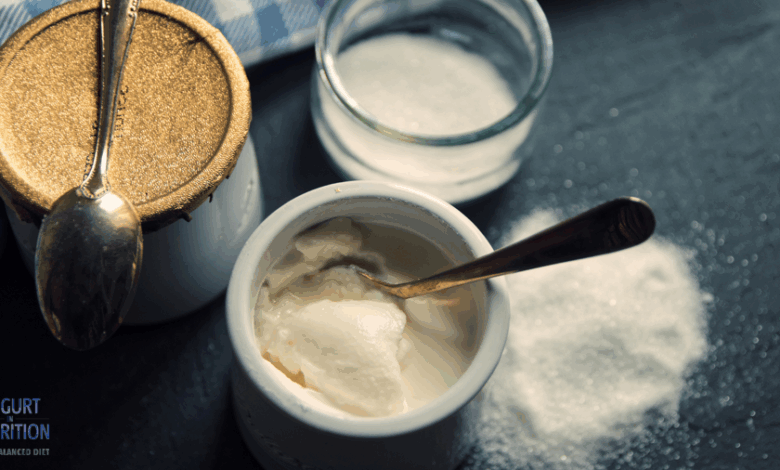
Your healthy yogurt might be full of sugar. We often assume yogurt is a healthy choice, but hidden sugars can easily sneak into even the seemingly wholesome options. This post delves into the surprising amount of sugar in various yogurts, revealing how marketing strategies and deceptive labeling can mislead consumers. We’ll explore different types of added sugars, compare popular brands, and discuss the potential health risks associated with excessive sugar consumption.
Prepare to uncover the truth about your favorite yogurt and discover healthier alternatives.
From understanding the common misconception that yogurt is inherently healthy to identifying hidden sugars and comparing different yogurt brands, this post aims to empower you with the knowledge to make informed choices. We’ll also look at healthier alternatives and how to make informed choices when selecting yogurt.
Understanding the Issue
Yogurt, often touted as a healthy breakfast or snack, can be surprisingly deceptive. The common perception of yogurt as a naturally nutritious food often overshadows the potential for hidden sugars and processed ingredients. This misconception can lead to significant dietary discrepancies and impact overall health. This exploration dives into the intricacies of yogurt’s sugar content, revealing how marketing strategies and ingredient choices can significantly influence the nutritional value of this seemingly wholesome food.Yogurt’s reputation for health often masks the variability in its nutritional profile.
Many yogurts, while containing beneficial probiotics, are laden with added sugars, undermining their purported health benefits. It’s crucial to understand the factors contributing to this discrepancy and how consumers can make informed choices.
Common Misconceptions about Yogurt
The perception of yogurt as a universally healthy food is a common misconception. While some yogurts offer probiotics and calcium, their sugar content can be high. This high sugar content can negate the positive effects of the probiotics and calcium. Many consumers assume that yogurt is inherently a healthy choice, often overlooking the significant variation in sugar content across different brands and types.
Examples of Deceptively High-Sugar Yogurts
Many flavored yogurts, marketed as healthy options, contain surprisingly high amounts of added sugars. Fruit-flavored yogurts, in particular, often have significant amounts of added sugar, sometimes exceeding the sugar content in comparable sugary drinks. Some yogurts, despite being marketed as “Greek” or “plain,” contain hidden sugars in the form of added sweeteners. These hidden sugars are often masked by marketing strategies, further misleading consumers.
Marketing Strategies and Sugar Content
Marketing strategies often play a crucial role in shaping consumer perception of yogurt. Intriguing packaging, colorful imagery, and catchy slogans often lead consumers to believe that the product is healthier than it actually is. The subtle presence of added sugars is often downplayed, while the benefits of probiotics or other health-related components are highlighted.
I was so excited to find this “healthy” yogurt, thinking it was a guilt-free treat. But then I checked the label and realized it was packed with sugar! It’s a similar disconnect to what’s happening with the opioid crisis; the White House rhetoric on the issue often doesn’t match the actual actions taken, as detailed in this article about the white house not walking the walk on opioid crisis.
Maybe I should just stick to plain yogurt and add my own fruit. It’s all a bit frustrating, isn’t it?
Types of Added Sugars in Yogurt
Added sugars in yogurt can take various forms. High-fructose corn syrup, sucrose (table sugar), and various natural sweeteners like agave nectar are frequently added to yogurt to enhance flavor and texture. These additions, often overlooked by consumers, can contribute significantly to the overall sugar content.
Comparison of Yogurt Brands and Sugar Content
Comparing different yogurt brands reveals a wide range of sugar content. Some brands prioritize minimal added sugars, while others readily add significant amounts of sweeteners. Consumers should carefully examine the ingredient list and nutrition labels to identify brands with lower sugar content.
Health Risks Associated with Excessive Sugar Consumption
Excessive sugar consumption is linked to various health risks, including weight gain, type 2 diabetes, heart disease, and dental problems. The high sugar content in some yogurts can contribute to these issues, particularly when consumed frequently.
Yogurt Sugar Content Comparison Table
| Yogurt Type | Average Sugar Content (grams per serving) |
|---|---|
| Plain Greek Yogurt | 3-5 |
| Plain Regular Yogurt | 5-7 |
| Flavored Yogurt | 10-20+ |
This table provides a general comparison of sugar content across different yogurt types. It is crucial to note that these are averages, and specific values may vary significantly based on the brand and flavor. Always consult the nutrition label for precise information.
Hidden Sugars in Yogurt

Yogurt, often touted as a healthy snack, can harbor surprising amounts of sugar. While some natural sugars are present in yogurt, manufacturers frequently add significant amounts of processed sugars to enhance flavor and texture, sometimes masking the true sugar content. This often happens without consumers fully realizing the extent of these added sugars. Understanding the different forms and how they’re hidden is crucial for making informed choices.Processed sugars come in various forms, each with its own potential impact on health.
Sucrose, the common table sugar, is frequently added to yogurt. High-fructose corn syrup, another common sweetener, is often used for its cost-effectiveness. These added sugars, whether in the form of simple sugars or complex ones, can contribute to increased calorie intake and negatively impact overall health.
Forms of Added Sugar
Added sugars can be found in various forms, each with its own chemical composition and potential impact on health. Sucrose, commonly known as table sugar, is a disaccharide composed of glucose and fructose. High-fructose corn syrup (HFCS) is a liquid sweetener derived from corn starch. It is often less expensive than sucrose and provides a similar level of sweetness.
Hey everyone, I was just thinking about how “healthy” yogurt can sometimes be surprisingly sugary. It’s easy to get caught up in the buzzwords, but hidden sugars can sneak into even the seemingly wholesome options. This got me thinking about broader health issues, like President Biden’s recent State of the Union address, where he outlined plans for drug pricing reform, mental health care improvements, and a “test-to-treat” COVID-19 strategy.
Biden’s state of the union address highlights the need for comprehensive solutions to complex problems. Ultimately, it just goes to show, you have to be a bit more discerning about what you’re putting into your body, even the healthy-sounding stuff, to truly maintain well-being.
Manufacturers might use HFCS to reduce costs or achieve a desired texture. Other sweeteners, like maltose and dextrose, are also used in various food products, including yogurt. Understanding these different forms helps consumers make informed choices about their consumption.
Hidden Sugar on Food Labels
Food labels can be surprisingly deceptive in revealing the true sugar content. Manufacturers employ various strategies to mask the high sugar content. Often, added sugars are listed under various names, making it challenging for consumers to quickly identify them. Common examples include “corn syrup,” “dextrose,” “maltose,” and “cane sugar.” The total amount of sugar may also be broken down into different components, which can be difficult to interpret.
Understanding the different names under which sugars can be listed is critical to making informed decisions about what you eat.
Ingredients Masking High Sugar Content
Numerous ingredients can be used to mask high sugar content in yogurt. These ingredients, often listed in the ingredient list, may not necessarily indicate the presence of high sugar content. For example, fruit flavors are frequently used to mask the taste of added sugars. Fruit purees, concentrated fruit juices, and other similar ingredients are common ways to add both flavor and sugars.
The use of artificial sweeteners and flavorings can also mask the presence of added sugars. Reading the entire ingredient list is essential to gaining a comprehensive understanding of the product.
Spotting Hidden Sugars on Food Labels
To spot hidden sugars on food labels, look beyond the “sugar” entry. Pay close attention to the ingredient list. If you see words like “corn syrup,” “dextrose,” “maltose,” “high-fructose corn syrup,” “cane sugar,” or similar terms, be aware that these are forms of added sugar. Furthermore, be aware of added fruit purees or concentrated fruit juices, as these may significantly increase the sugar content.
Summing up the amount of sugar from different sources is crucial to fully understanding the product’s sugar content.
Okay, so I’ve been on this healthy eating kick lately, and while I’m trying to be mindful of my sugar intake, it’s surprising how much sugar can hide in seemingly healthy foods like yogurt. It’s a real eye-opener, and honestly, a little unsettling. This issue of hidden sugar isn’t just about my yogurt; it’s a bit like the shocking rise in teen overdose deaths due to fentanyl, a serious public health crisis that’s hitting communities hard.
This article really dives deep into the issue. So, while I’m trying to make smart food choices, I’m also learning to be more aware of the sneaky ways sugar can creep into my diet. My healthy yogurt might be full of sugar, and that’s a bit of a bummer.
Yogurt Brand Sugar Content Comparison
| Yogurt Brand | Sugar Content (per serving) | Hidden Sugars |
|---|---|---|
| Brand A | 15g | High-fructose corn syrup, dextrose |
| Brand B | 10g | Sucrose, fruit juice concentrate |
| Brand C | 18g | High-fructose corn syrup, maltose, added fruit flavor |
| Brand D | 6g | None Detected |
Note: This table is for illustrative purposes only. Actual sugar content may vary. Always check the product label for the most up-to-date information.
Marketing and Health Claims
Yogurt manufacturers often promote their products’ health benefits without fully disclosing the sugar content. Marketing strategies can focus on the “good bacteria” or other perceived health benefits without highlighting the added sugars. Consumers should be aware of this marketing strategy and thoroughly check the nutrition facts to make an informed decision.
Healthy Alternatives: Your Healthy Yogurt Might Be Full Of Sugar
Discovering lower-sugar yogurt options is crucial for maintaining a healthy diet. Many popular brands often contain hidden sugars, leading to unexpected calorie and sugar intake. This section explores healthier alternatives, comparing brands and their sugar content, and delves into the nutritional benefits and the process of making your own yogurt.
Lower-Sugar Yogurt Brands, Your healthy yogurt might be full of sugar
Choosing yogurt with a lower sugar content requires careful comparison of labels. Different brands offer varying levels of sugar, affecting their nutritional profiles. Analyzing labels is essential to understand the sugar content and total calories. By making informed choices, you can find options that align with your health goals.
- Several brands offer Greek yogurt with reduced sugar content. Look for options that list natural ingredients as primary components, minimizing processed additives.
- Some brands emphasize “plain” or “unsweetened” yogurt, offering a base for flavor customization with natural sweeteners like fruit or honey, thus controlling the added sugar.
- Many dairy-free yogurt alternatives, like coconut or almond yogurt, naturally contain lower sugar levels compared to dairy yogurt. However, even these can contain added sugars, so always check the label.
Comparison Table: Low-Sugar Yogurt Alternatives
This table provides a quick overview of different brands and their sugar content. Comparing these values helps make informed choices. Note that values may vary slightly based on specific product varieties.
| Brand | Type | Sugar Content (grams per serving) | Additional Notes |
|---|---|---|---|
| Brand A | Plain Greek Yogurt | 5 | Often has added probiotics and protein |
| Brand B | Coconut Yogurt | 2 | Generally lower in calories and sugar |
| Brand C | Almond Yogurt | 6 | May contain added sugars, check label |
| Brand D | Plain Dairy Yogurt | 8 | A good base for homemade yogurt |
Nutritional Value of Lower-Sugar Alternatives
Lower-sugar yogurt alternatives often provide similar protein and calcium content to their higher-sugar counterparts. The nutritional profile varies depending on the specific brand and type of yogurt. Lower-sugar options may offer a more balanced nutritional profile.
Homemade Yogurt: Controlling Sugar
Making yogurt at home allows complete control over ingredients and sugar content. This gives you the freedom to tailor the yogurt to your preferences.
Homemade Yogurt vs. Store-Bought
Homemade yogurt offers flexibility in controlling ingredients, including sugar. However, it requires more time and effort compared to store-bought yogurt.
Homemade yogurt provides a healthier alternative with greater control over ingredients, while store-bought options offer convenience.
- Homemade yogurt: Provides complete control over ingredients, including sugar content, potentially reducing added sugars. It requires more time and effort, but the taste and nutritional value are tailored to your preferences. The yogurt making process itself isn’t complex but requires a bit of patience and preparation.
- Store-bought yogurt: Offers convenience, but the sugar content can vary widely. Choosing low-sugar options is essential for a healthier choice.
Homemade Yogurt Recipe: Ingredients and Nutritional Value
The following table presents a sample recipe for homemade yogurt and its approximate nutritional value per serving. Adjust ingredients to achieve desired sugar levels.
| Ingredient | Quantity | Nutritional Value (Approximate) |
|---|---|---|
| Milk (whole or low-fat) | 1 liter | Calories: 600-800, Protein: 8-10g, Calcium: 250-300mg |
| Yogurt starter culture | 1 tablespoon | Live cultures, aiding digestion |
| Natural sweetener (optional) | 1-2 tablespoons | Adjust to taste and desired sugar level |
Consumer Awareness
Navigating the yogurt aisle can be tricky, especially when aiming for a healthy choice. Many consumers are unaware of the hidden sugars lurking in seemingly healthy options. This often leads to unintended calorie and sugar intake, hindering health goals. Understanding how to critically evaluate yogurt labels and identify healthier alternatives is crucial for informed purchasing decisions.Consumers frequently make assumptions about yogurt based on its perceived healthfulness, overlooking the crucial detail of sugar content.
This can lead to significant discrepancies between expected and actual nutritional value. Educating ourselves about sugar content in yogurt is paramount to making mindful choices.
Common Consumer Mistakes When Choosing Yogurt
Consumers often fall prey to marketing strategies that emphasize yogurt’s purported health benefits without adequately disclosing the sugar content. This can lead to overlooking important nutritional information. For instance, a yogurt marketed as “low-fat” might still contain high levels of added sugars. Similarly, consumers might be misled by terms like “natural” or “organic,” which don’t automatically translate to low sugar.
Choosing yogurt solely based on flavor and texture without considering the sugar content can result in unintended consumption of added sugars.
Practical Tips for Making Healthier Yogurt Choices
Carefully scrutinizing the ingredient list is crucial. Look for yogurt varieties with minimal added sugars. Avoid products with words like “syrup,” “cane juice,” or “fruit juice concentrate” high on the list. Instead, opt for yogurt with fruit naturally present. The amount of fruit naturally occurring in the yogurt is often indicated in the ingredient list, as well as the nutrition label.
Consider the total sugar content in grams per serving, as indicated on the nutrition label. Compare similar yogurt products to find the ones with the lowest sugar content.
Strategies for Educating Consumers about Sugar Content in Food
Public awareness campaigns focusing on the hidden sugars in yogurt and other foods are essential. These campaigns should highlight the importance of reading nutrition labels and understanding the impact of sugar on health. Promoting educational resources, such as websites and infographics, that clearly explain sugar content and its implications is another effective strategy. Nutrition labels need to be clear and concise, providing a clear indication of sugar content and avoiding jargon.
How to Critically Evaluate Food Labels for Sugar Content
Understanding how to interpret nutrition labels is key. Pay close attention to the “Total Sugars” line, which includes naturally occurring sugars plus added sugars. Also note the “Added Sugars” line, as this provides a clearer picture of the sugars added during processing. Compare products with similar serving sizes to identify the ones with the lowest sugar content.
Look for yogurts with naturally occurring sugars like those found in fruit, which are often better for you.
Detailing the Importance of Reading Ingredient Lists and Nutritional Labels Carefully
Reading ingredient lists and nutritional labels carefully is critical for making informed decisions. The ingredient list shows the order of ingredients by weight, with the most abundant ingredients appearing first. By understanding the order, consumers can determine the presence and amount of added sugars. The nutrition label provides information on the nutritional value per serving, including the total sugars and added sugars.
By understanding the information on these labels, you can make more informed decisions.
Resources for Consumers to Find Low-Sugar Yogurt
Several online resources provide comprehensive information on low-sugar yogurt options. Health-conscious websites and blogs often compile lists of low-sugar yogurt brands and products. Specialized dietary apps can help track sugar intake and provide recommendations for low-sugar alternatives. Many supermarkets have sections dedicated to low-sugar or natural foods.
Summary of Common Consumer Mistakes and Their Solutions
| Consumer Mistake | Solution |
|---|---|
| Choosing yogurt based solely on perceived healthiness without checking sugar content | Carefully read ingredient and nutrition labels to identify total sugars and added sugars. |
| Ignoring the ingredient list and nutritional label | Thoroughly review the ingredient list for added sugars and the nutrition label for total and added sugars. |
| Failing to compare similar products based on sugar content | Compare different products side-by-side, considering serving size and sugar content. |
Impact on Health

High sugar intake, even in seemingly healthy foods like yogurt, can significantly impact overall well-being. The hidden sugars in processed foods, including some yogurts, can contribute to a variety of health problems. Understanding these effects is crucial for making informed choices about our diets.Excessive sugar consumption disrupts the body’s natural metabolic processes, leading to a range of health issues, from weight gain to chronic diseases.
The correlation between sugar intake and these problems is well-documented, highlighting the importance of mindful food choices.
Correlation with Health Issues
High sugar intake is strongly linked to numerous health problems. Sugary foods often lack essential nutrients, while providing a significant amount of empty calories. This imbalance can lead to deficiencies in vitamins and minerals necessary for optimal bodily functions. Moreover, excessive sugar consumption can contribute to insulin resistance, which, over time, can increase the risk of developing type 2 diabetes.
Impact on Weight Management
Sugary foods, including high-sugar yogurt, often contribute to weight gain. The body’s immediate response to sugar is a spike in blood glucose levels. This triggers the release of insulin, which, in turn, promotes the storage of excess glucose as fat. Consequently, regular consumption of high-sugar foods can lead to a gradual increase in body fat and a higher risk of obesity.
Connection to Chronic Diseases
Studies have consistently shown a strong association between high sugar intake and an increased risk of chronic diseases. Chronic diseases like heart disease, certain types of cancer, and kidney disease are significantly linked to poor dietary habits, including excessive sugar consumption. This is because excessive sugar consumption can contribute to inflammation, high blood pressure, and high cholesterol levels, all of which are major risk factors for chronic diseases.
Health Problems Linked to Excessive Sugar Intake
Excessive sugar intake is associated with a wide range of health issues. These problems can range from relatively minor concerns to more serious conditions. It’s important to understand the potential consequences of consuming too much sugar.
- Weight gain and obesity: The body stores excess sugar as fat, leading to gradual weight gain and increasing the risk of obesity.
- Type 2 diabetes: Excessive sugar consumption can contribute to insulin resistance, increasing the risk of developing type 2 diabetes.
- Heart disease: High blood pressure, high cholesterol, and inflammation, all linked to high sugar intake, can significantly increase the risk of heart disease.
- Dental problems: Sugar feeds bacteria in the mouth, contributing to tooth decay and gum disease.
- Liver disease: Excess sugar can put a strain on the liver, potentially leading to conditions like fatty liver disease.
- Certain types of cancer: Some studies suggest a correlation between high sugar intake and an increased risk of certain cancers, but the exact mechanisms are still under investigation.
- Metabolic syndrome: A cluster of conditions, including high blood pressure, high blood sugar, excess body fat around the waist, and abnormal cholesterol levels, is strongly linked to excessive sugar consumption.
Nutritional Profile Comparison
High-sugar yogurt often lacks the nutritional benefits of low-sugar options. High-sugar varieties often rely on added sugars, which offer no nutritional value, while low-sugar options may retain more of the naturally occurring nutrients from the milk and bacteria. The difference in nutritional content is a critical factor in choosing between high-sugar and low-sugar options.
Potential Health Risks by Sugar Levels
The table below illustrates the potential health risks associated with different sugar levels in yogurt. It highlights the increasing risk as the sugar content rises.
| Sugar Level | Potential Health Risks |
|---|---|
| Low | Minimal risk of adverse health effects |
| Moderate | Increased risk of weight gain and minor health issues |
| High | Increased risk of weight gain, chronic diseases, and other health complications |
Conclusive Thoughts
So, the next time you reach for that yogurt, remember to be a savvy consumer. Look beyond the marketing hype and delve into the nutritional information. By understanding the hidden sugars and making informed choices, you can enjoy yogurt as part of a balanced and healthy diet. Armed with the knowledge in this post, you’re empowered to choose healthier options and make better choices about your health.





